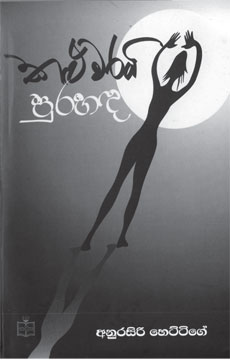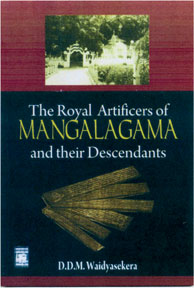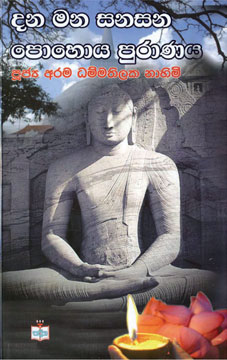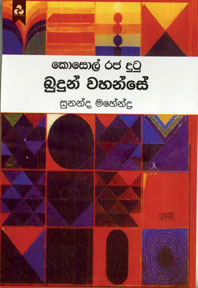|

Let's read a 'weeping novel'
Reviewed by Hemaratne Liyanarachchi
A writer with an immense and indisputable creative power has, at
last, appeared at the threshold of our Sinhala literature. He may,
during his itinerant period of search for identity and recognition, have
been tapping at the doors to make his presence felt without result.
But today he has hit, it seems, at the right spot at the opportune
moment; and there he stands, garrisoned, as it were, compelling us to
admit him.
|

Kaluwarai Pura Handa |
Yes, he stands There Gerasim-like, this time hot just tapping but
banging with the fists of Gerasim, the dumb giant serf of Ivan Turgenev
not with Mumu his pet dog, but with his weeping novel, Kaluwarai Pura
Handa tucked under his armpit....
But look! Our Gerasim Speaks!
Wonder world
He speaks neither of Russian Serfdom, nor of the nether world visits
of Odysseus in Homer, but of the nether region, the wonder world of
Colombo! The final result of which has turned out to be an evocation of
the capital's underworld life in its full blooded corporeality. Never
has a Sinhala novelist, hitherto made his Homeric descent in to this
damned underworld of the capital of this blessed island which
capitulates such captivating and detailed exposure with such on-the-spot
immediacy.
Without any more dawdling let me begin from the very beginning.
Kaluwarai Pura Handa starts with a four-paged preamble to the social
background of the characters immediately followed up by a short run of
pop ups of the main characters; Janadasa, Piyawathie, Ranjanie and
Kalumahaththaya. These introductory peepings are very much reminiscent
of the character launches which appear in some Greek tragedies as well
as in some Sarachchandra dramas. They also help the author to set in
motion his story in a smooth manner so that the reader is not
unnecessarily taxed or burdened with unexpected dilemmas or
perplexities.
Protagonist
Let me also try to give the story of the novel in a nutshell.
Janadasa, the apparent hero of the novel, is a journalist who
contributes a column to a left oriented newspaper under the pen-name 'Meemassa'
– the Bee – He has visited Piyawathie. The prostitute, prior to the
start of the novel, and also has established a relationship which later
matures into a love. This development demands Janadasa to lead a family
life with Piyawathie and her two children, Ranjanie the beautiful girl
and a boy. These developments are a pointer to the most unconventional
attitude to life of the journalist.
Ranjanie grows up under the mother's strict observation she does not
want to see Ranjanie become a prostitute. But the girl runs away with a
young lad who promptly turns out to be a drug-addict. Her life ruined,
she is forced to be a prostitute – Piyawathie, after Ranjanie's
elopement lives in utter distress only to become an invalid cared for by
Janadasa who by now has become a full fledged slum dweller but for his
gentle qualities. Klumahaththaya at the start of the novel is a gangster
hired by businessmen for their ends who earns big money through drug
dealing.
He enters the top circle of politicians and businessmen who then,
like others strive to go up the ladder of politics. In the meantime, he
'saved' Ranjanie from the brothel only to keep her as his concubine.
When he is about to get his nominations for local politics unexpectedly
he is stained by one of the 'unidentified gunmen' who reminds the reader
of the troubled eighties of political assassinations. Janadasa who comes
from 'no-where' again takes to the road to continue the long journey of
the lonely traveller.
Variety
The story of 'Kaluwarai Pura Handa' (Dark is the moon) is richly
studded with many characters of variety who despite their brimming
vigour of life dance their way into the untold depth of suffering which
fact accounts for the unconscionable and unceasing exploitation at work.
They, as a society, are manipulated by an unseen, huge machine behind
which sits the faceless politician, the master.
Not one, but even several Janadasas, the author seems to suggest,
could ever be able to bring about an end to this vicious dance of death
going on endlessly in the face of faceless politics. The artist cannot,
obviously offer a solution fo art has to stop where philosophy and
politics have to begin.
But the writer has, quite knowledgeably, compensated for his
seemingly 'evasive stride' by a very careful enrichment of the plot,
characterisation and language of course with the exception of some
questionable wielders. Long after the reader has finished, the three
aspects mentioned above, I presume will continue to haunt him.
Developments
The most magnetic of the three, the plot, is ever evolving I say,
because it keeps on developing and enlarging as the story proceeds. It
incorporates into itself the innumerable developments of character,
situation and also of the network of logicality involved in the making
of the plot.
We must be able to differentiate between the plot, structure and
story.
It suffices, I believe, to give the one example of the etching of
Kalumahaththaya - one of the best characterisations to be found in
modern Sinhala fiction - for all the three, aspects noted above. Kalu's
character grows from childhood to manhood, from underling to chief drug
dealer, from slum dweller to mansion owner. He enlarges in so many
facets interlacing them to evince a most complex character street boy,
an innocent victim of an elderly homosexual, street fighter, lackey of
merchants, rich drug dealer and simultaneously the gentle man capable of
love, tenderness and friendship.
Kalu becomes too dynamic and big that he displaces Janadasa to the
position of apparent hero. The novelist bestows on Kalu the slum dialect
as on other characters but with a difference. It abounds in a
confessional and poetic tone which flavours Kalu's character with a
gentleness. he craves for the vessel of ardent friendship into which he
could pour out the fermenting and bubbling thoughts which issue forth
from the depth of his being. This sacred moment of the dearness of heart
in Kalu is a bright ray dazzling in the thick darkness which signifies a
possibility of redemption.
Language
A word about the use of the language. Hettige has exploited to the
utmost the vigorous slum dialect by which the reader is entranced from
the start to the finish. But, I also feel that this dialect should not
be used for narration for this area is common ground even to the future
reader. This language is in a speedy process of transmutation. There is
also a very clever use of the narrative method. The novelist keeps on
intertwining the streams of thoughts of several characters at one and
the same time for the flow of the story without his participation as
author.
I have called this remarkable work a 'weeping novel' for several
obvious reasons, two of which stand out very marked.
Firstly, almost all the characters, either consciously or
unconsciously weep for they know that an unavoidable tragedy engulfs
their lives. Secondly, they also are aware of the fact that they are
destined to fall short of the most scanty happiness a human being aught
to get.
Well - researched work on royal artificers
Reviewed by Pemsiri de Silva
In its long history of over 2500 years, Sri Lanka has produced a host
of historic sites, families, architecture, arts and crafts, folklore
among other traditions in different parts of the country. It is
difficult to trace the ancestry and history of these families and their
works for lack of consistent records but a number of sources including
official documents, records from the National Archives and other
libraries, various sannasas granted by the Sinhala Kings, lekammiti,
vittipatra, tudapat, kadaimpoth etc. and research of other scholars
among other sources are available to the earnest researcher.
|

Author: D.D.M. Waidyasekera
Published by Stamford Lake (Pvt) Ltd. |
In the case of artificers or craftsmen, the task is more difficult
for as Ananda Coomaraswamy states," the names of artificers are not
recorded in their work nor as a rule remembered except by their own
descendants."
The book is an attempt to trace the history, ancestry and the works
as well as the descendants of the royal artificers of an ancient village
Mangalagama in the Kandyan Udarata. The village itself lies on the 54th
milepost on the Colombo - Kandy road and is markedly visible by two of
its characteristics in the form of its ancient Vihara and the ancient
ambalama, now renovated. The village assumes historical importance
because as Paranavitana states, "The role played by the Mangalagama
craftsmen in the Kandyan Court was unique."
The study commences with a description of the origins of the clan of
artificers in India, its mythical ancestor Viswakarama regarded as the
revealer of the science of architecture and mechanics, their advent to
Sri Lanka both before and after Vijaya in 483 BC and Sanghamitta who
brought the Bo-tree in 289 BC. The origins of the village, its Bo-tree
and ambalama are traced more particularly from the 15th century AD.
Bhuvanekabahu
During the reign of Bhuvanekabahu VI of Kotte (AD 1469-1477) there
came a reputed Mulachariya from Dambadiva, who was brought to Kotte with
full honours on the King's own elephant. The Mulachariya presented the
king with a telescope and an hour glass (clock), In return for which the
King granted him the village of Mangalagama as a nindagama and bestowed
on him the title 'Mandalawalli.' All these facts and the Sannasas
granted are recorded in the Vitti Patraya and given in Bell's Report on
the Kegalla District 1892 and produced in the Appendix to the book.
Another chapter of the book gives particulars regarding the various
sannasas granted at different times by the Sinhala Kings to the
descendant families particularly in the Kandyan districts and supported
by reference to such researchers as Codrington, Lawrie's Gazetteer, Bell
etc. The details of the Mangalagama Vihara, and Bo-tree, particulars of
the ancient ambalama especially its unique timbered roof and decorated
pekada pillars as described so aptly in Ananda Coomaraswamy's
masterpiece "Medieval Sinhalese Art" are provided in detail with
relevant illustrations and gives a fascinating insight into the
uniqueness of some of the historical structures of the country.
Another feature of the study is the author's research into the life
and works of the unique Kandyan designer and architect builder Dewendra
Mulachariya who is credited with designing and construction of the
Pattiripuwa or Octagon of the Dalada Maligawa, other such works as the
Magul Maduwa or audience hall and the highly original concept of the
Cloud Wall or Walakul Bamma surrounding the Kandy Lake. He worked under
three Kings, Kirti Sri Rajasinha, Rajadhi Rajasinha and Sri Wickrema
Rajasinha. However, little is known or has been written of the life and
works of this brilliant Kandyan designer builder.
His other architectural works and the stories behind the building of
the Octagon, Magul Maduwa, the Cloud wall are described which provide an
interesting insight into the intrigues prevalent in the Kandyan Court at
the time and which ultimately led to his drowning himself in the Kandy
Lake. The author has also researched into his family and descendants
based on the Judicial Commissioner's Court Proceedings of the early
nineteenth century in the Kandy Archives.
Painters
Another interesting feature of the book is the description of the
works of the Kandyan painters or Sittaru, during this period. As a rule
the names of the painters themselves are not given in the paintings and
are known mostly through the various sannasas granted by the Kings as a
reward for their work, illustrations are provided of some of the wall
paintings in Dambulla, Gangarama, Degaldoruwa, Ridi Vihara and the
Dalada Maligawa and the names of the relevant painters are given in the
book.
Illustrations and descriptions are also provided of the jewellery and
other ornaments produced for the Kings by the Mangalagama royal
artificers as well as specimens of the ancient Sinhala royal crowns and
the evolution of their designs from the Anuradhapura period (including
that of Dutugemunu and Valagamba) to the 18th and 19th centuries and
which is a unique feature of the book.
Finally, details of the recent descendants and their families are
also provided including genealogy charts, interesting photographs etc.
The appendix provides very useful information on ancient vitti patra and
tudapat as well as old court records and law reports as supporting
evidence for the study.
The author has utilised a number of references in the study including
those of reputed scholars as Ananda Coomaraswamy, H. W. Codrington, H.
C. P. Bell, A. C. Lawrie, Lorna Devaraja, K. D. Paranavitana among
others, the details of which are provided and duly acknowledged.
Historical research
It is interesting to note that the author being a former Commissioner
of Inland Revenue and is more knowledgeable on taxation, fiscal policy
and economics on which he has written to various books and journals, has
in this present volume ventured into the field of historical research
perhaps on the influence of his former professors and lecturers in
History and Sociology at the Peradeniya campus in its halcyon days.
In this he is not alone as one of his own colleagues in the
department the late Gaston Perera also did the same in deviating from
taxation to historical novels of the Kandyan period, as is well known.
The contents of the book would be of interest to scholars,
researchers, students, historians, social scientists as well as to the
general reader alike.
Lucid explanation of the significance of Poya days
Reviewed by Prof. Jayadeva Tilakasiri
Buddhism and Buddhist devotees have always received ample explanation
and relevant expositions of its salient teachings.
|

Dana Mana Sanasana
Pohoya puranaya
Author: Ven. Arama
Dhammathilaka
Sadeepa Publishers, Colombo 8 |
It is no exaggeration to state that the Buddha's teaching and
spiritual attainment have led to lucid comments and philosophical
theorising.
The learned monks and even the prelates steeped in Dhamma learning
and practice of the precepts have served as the most efficient purveyors
of the essentials of the Buddha Dhamma.
The Arama Dhammatilaka Nayaka Thera is a very able exponent of the
teachings, his contributions to magazines, journals and the press have
benefitted both the educated laity and the average followers of the
fundamental and even philosophical explanations.
Simple language
It is in this context that the above book and the series of
publications he has to his credit that a reader is impressed with his
ability to unfold in simple language the essentials of Buddhist
religion, too which carries a great appeal to the devotees who need a
proper onderstanding of the truths discovered by the Great Teacher
thousands of years ago.
The theme of the book is the 12-month observance of the varied
rituals and the intense study of the rites and practices especially
connected with the devotion and dedication required to improve the
knowledge of the realities of present day living unfolded in the sermons
which venerable theras are able to present to the people on special
occasions or assemblies in temples and shrines.
As the venerable prelate has acquired the ability to preach and write
on the Buddhist themes relevant for the lay devotees who expect to hear
from such experienced preachers his present title Dana Mana Sansana
Pohoya Puranaya is indeed very topical and serving the purpose.
In his distribution of topics and subject matter in the book he has
accomplished the aim of bringing the temple the observances, the
offerings, the discussions into a coordinated scheme in order to make
the holy poya day relevant and meaningful for the Buddhist laity.
Eminence
As the title indicates the author's eminence in many fields of
learning, secular and religious, and the professional and academic
attainments reflect the value of a booklet appealing to the ordinary
folk who do not miss temple going on poya days.
It is also necessary to make a comment on the style and language of
the chapters of the book, based on the contributions made by the author
to the press, and published earlier. It is therefore, presented in a
lucid, easily understood diction considering the wide coverage of
readers of such books.
Reading of this book and considering the special appeal to readers it
is beneficial to many who go through their journey in Sansara (worldly
living) facing difficulties not merely physical, but mental also
requiring spiritual solace such as is provided by the author's
intention.
 BOOK LAUNCH BOOK LAUNCH
Kosol Raja Dutu Budun Vahanse
Prof. Sunanda Mahendra's latest Sinhala book Kosol Raja Dutu Budun
Vahanse was launched at Dayawansa Jayakody Bookshop, Colombo 10
recently. Prof. Mahendra is the author of Devdath Mavata Menavi Dangara
Tharappuva, Metteiya Thera Vata, Niruvath Devivaru and Niralambanaya.
Kosol Raja Dutu Budun Vahanse is a Dayawansa Jayakody publication.
NEW ARRIVAL
Vidya Vinodaya
 Anura C. Perera’s Vidya Vinodaya was recently launched as a Vidura
Vidya Publication Anura C. Perera’s Vidya Vinodaya was recently launched as a Vidura
Vidya Publication |

